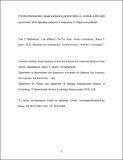The thrombospondin repeat containing protein MIG-21 controls a left–right asymmetric Wnt signaling response in migrating C. elegans neuroblasts
Author(s)
Middelkoop, Teije C.; Williams, Lisa; Yang, Pei-Tzu; Luchtenberg, Jeroen; Betist, Marco C.; Ji, Ni; van Oudenaarden, Alexander; Kenyon, Cynthia; Korswagen, Hendrik C.; ... Show more Show less
Downloadvan Oudenaarden_The Thrombospondin.pdf (258.0Kb)
PUBLISHER_CC
Publisher with Creative Commons License
Creative Commons Attribution
Terms of use
Metadata
Show full item recordAbstract
Wnt proteins are secreted signaling molecules that play a central role in development and adult tissue homeostasis. Although several Wnt signal transduction mechanisms have been described in detail, it is still largely unknown how cells are specified to adopt such different Wnt signaling responses. Here, we have used the stereotypic migration of the C. elegans Q neuroblasts as a model to study how two initially equivalent cells are instructed to activate either β-catenin dependent or independent Wnt signaling pathways to control the migration of their descendants along the anteroposterior axis. We find that the specification of this difference in Wnt signaling response is dependent on the thrombospondin repeat containing protein MIG-21, which acts together with the netrin receptor UNC-40/DCC to control an initial left–right asymmetric polarization of the Q neuroblasts. Furthermore, we show that the direction of this polarization determines the threshold for Wnt/β-catenin signaling, with posterior polarization sensitizing for activation of this pathway. We conclude that MIG-21 and UNC-40 control the asymmetry in Wnt signaling response by restricting posterior polarization to one of the two Q neuroblasts.
Date issued
2012-01Department
Massachusetts Institute of Technology. Department of Biology; Massachusetts Institute of Technology. Department of Brain and Cognitive Sciences; Massachusetts Institute of Technology. Department of PhysicsJournal
Developmental Biology
Publisher
Elsevier
Citation
Middelkoop, Teije C., Lisa Williams, Pei-Tzu Yang, Jeroen Luchtenberg, Marco C. Betist, Ni Ji, Alexander van Oudenaarden, Cynthia Kenyon, and Hendrik C. Korswagen. “The Thrombospondin Repeat Containing Protein MIG-21 Controls a Left–right Asymmetric Wnt Signaling Response in Migrating C. Elegans Neuroblasts.” Developmental Biology 361, no. 2 (January 2012): 338–348.
Version: Author's final manuscript
ISSN
0012-1606
1095-564X
